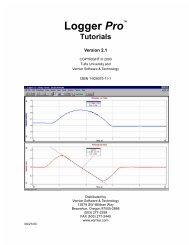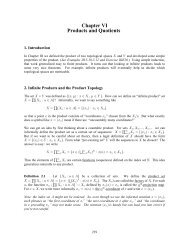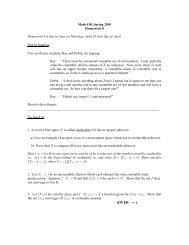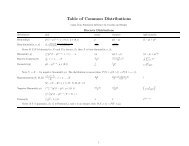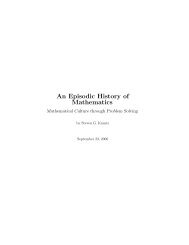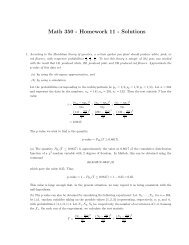Solution [pdf]
Solution [pdf]
Solution [pdf]
You also want an ePaper? Increase the reach of your titles
YUMPU automatically turns print PDFs into web optimized ePapers that Google loves.
HOMEWORK 9 SOLUTION<br />
MATH 5051, FALL 2012<br />
Exercise 1 (Folland, 5.31). Let X, Y be Banach spaces and let S : X → Y be<br />
an unbounded linear map. Let Γ(S) be the graph of S, a subspace of X × Y.<br />
a. Γ(S) is not complete.<br />
Proof. Since S is unbounded, the Closed Graph Theorem implies<br />
that Γ(S) is not closed. Hence, there exists a Cauchy sequence<br />
(xn, Sxn) → (x, y) /∈ Γ(S), so Γ(S) is not complete. �<br />
b. Define T : X → Γ(S) by T x = (x, Sx). Then T is closed but not<br />
bounded.<br />
Proof. Suppose xn → x and T xn = (xn, Sxn) → (x ′ , Sx ′ ) ∈ Γ(S).<br />
Since �xn − x ′ � ≤ � � (xn, Sxn) − (x ′ , Sx ′ ) � � → 0, it follows that xn →<br />
x ′ = x. Thus, (x ′ , Sx ′ ) = (x, Sx) = T x, so T is closed.<br />
On the other hand, notice that S = π2 ◦ T . Since π2 is bounded<br />
and S is unbounded, T must also be unbounded. �<br />
c. T −1 : Γ(S) → X is bounded and surjective but not open.<br />
Proof. Clearly T −1 = π1 is bounded, since �x� ≤ � � (x, Sx) � �, and<br />
surjective since x = T −1 (T x) for all x ∈ X. However, if T −1 were<br />
open, that would imply that T was continuous and hence bounded,<br />
which is not the case. �<br />
Exercise 2 (Folland, 5.32). Let �·�1 and �·�2 be norms on the vector space<br />
X such that �·�1 ≤ �·�2. If X is complete with respect to both norms, then<br />
the norms are equivalent.<br />
Proof. Since �x�1 ≤ �x�2 for all x ∈ X, the identity mapping x ↦→ x is a<br />
bounded bijection � � � �<br />
X, �·�2 → X, �·�1 . Hence, by the Bounded Inverse<br />
Theorem (Corollary 5.11), its inverse is also bounded, i.e., there exists C > 0<br />
such that �x�2 ≤ C�x�1 for all x ∈ X. �<br />
Exercise 3 (Folland, Exercise 5.37). Let X and Y be Banach spaces. If<br />
T : X → Y is a linear map such that f ◦ T ∈ X ∗ for every f ∈ Y ∗ , then T is<br />
bounded.<br />
Proof. By the Closed Graph Theorem, it suffices to show that T is closed.<br />
Suppose that xn → x ∈ X and T xn → y ∈ Y. Then for all f ∈ Y ∗ , it follows<br />
that f(T xn) → f(y), and since f ◦ T ∈ X ∗ , we also have f(T xn) → f(T x).<br />
Hence, f(y) = f(T x) for all f ∈ Y ∗ , but since bounded linear functionals<br />
separate points, it follows that y = T x, and therefore T is closed.<br />
1
2 MATH 5051, FALL 2012<br />
Alternatively, we could have applied the Uniform Boundedness Principle.<br />
Since f ◦ T ∈ X ∗ for all f ∈ Y ∗ , we have<br />
and therefore<br />
sup �<br />
�x�=1<br />
� T x(f)� = sup �f(T x)� < ∞,<br />
�x�=1<br />
sup �T x� = sup �<br />
�x�=1 �x�=1<br />
� T x� < ∞,<br />
so T is bounded. �<br />
Exercise 4 (Folland, Exercise 5.44). If X is a first countable topological<br />
vector space and every Cauchy sequence in X converges, then every Cauchy<br />
net in X converges.<br />
Proof. Let 〈xi〉i∈I be a Cauchy net, i.e., 〈xi − xj〉 (i,j)∈I×I → 0. Since X is<br />
first countable, 0 has a countable neighborhood base {Un} ∞ n=1 , and we can<br />
assume that U1 ⊃ U2 ⊃ · · · . Now, since 〈xi − xj〉 (i,j)∈I×I → 0, it follows<br />
that there exists some (i1, j1) ∈ I × I such that (xi − xj) ∈ U1 whenever<br />
i � i1 and j � j1. In particular, we can take k1 ∈ I such that k1 � i1, j1,<br />
so (xi − xj) ∈ U1 whenever i, j � k1. We can repeat this for any n ∈ N, so<br />
there exists kn ∈ I such that (xi − xj) ∈ Un whenever i, j � kn. Hence, the<br />
sequence {xkn }∞n=1 is Cauchy, so xkn → x ∈ X, and it follows immediately<br />
that xi → x as well. �<br />
Exercise 5 (Folland, Exercise 5.46). If X is a vector space, Y a normed<br />
linear space, T the weak topology on X generated by a family of linear maps<br />
{Tα : X → Y}, and T ′ the topology defined by the seminorms � x ↦→ �Tαx� � ,<br />
then T = T ′ .<br />
Proof. The topology T has base elements � x : �Tαx − y0� < ɛ � , while T ′ has<br />
base � x : �Tαx − Tαx0� < ɛ � . Clearly T ′ ⊂ T, so it suffices to show that the<br />
reverse inclusion holds. If �Tαx0 − y0� < ɛ, then let δ = ɛ − �Tαx0 − y0�,<br />
and it follows that �Tαx − Tαx0� < δ implies<br />
�Tαx − y0� ≤ �Tαx − Tαx0� + �Tαx0 − y0� < ɛ.<br />
Hence, � x ∈ X : �Tαx − Tαx0� < δ � ⊂ � x ∈ X : �Tαx − y0� < ɛ � . �<br />
Exercise 6 (Folland, Exercise 5.47). Suppose that X and Y are Banach<br />
spaces.<br />
a. If {Tn} ∞ n=1 ⊂ L(X, Y) and Tn → T weakly (or strongly), then<br />
sup n�Tn� < ∞.<br />
Proof. By definition, Tn → T weakly means that f(Tnx) → f(T x)<br />
for all x ∈ X, f ∈ Y∗ . Therefore, the sequence f(Tnx) = � �<br />
Tnx(f) is<br />
bounded, so sup ��<br />
n Tnx(f) � � < ∞, and by the uniform boundedness<br />
principle, supn� � Tnx� = supn�Tnx� < ∞. Finally, applying the<br />
uniform boundedness principle again, we get supn�Tn� < ∞. �
HOMEWORK 9 SOLUTION 3<br />
b. Every weakly convergent sequence in X, and every weak*-convergent<br />
sequence in X∗ , is bounded (with respect to the norm).<br />
Proof. If xn → x weakly in X, then f(xn) → f(x) for all f ∈ X∗ � , so<br />
the sequence f(xn) = �xn(f) is bounded. That is, sup ��xn(f) n<br />
� � < ∞<br />
for all f ∈ X ∗ , so by the uniform boundedness principle, sup n��xn� =<br />
sup n�xn� < ∞.<br />
Similarly, if fn → f in X ∗ with the weak*-topology, then fn(x) →<br />
f(x) �for<br />
all x ∈ X, so the sequence fn(x) is bounded. Therefore,<br />
sup �fn(x) n<br />
� � < ∞ for all x ∈ X, and the uniform boundedness principle<br />
implies supn�fn� < ∞. �


![Solution [pdf]](https://img.yumpu.com/8357464/1/500x640/solution-pdf.jpg)
